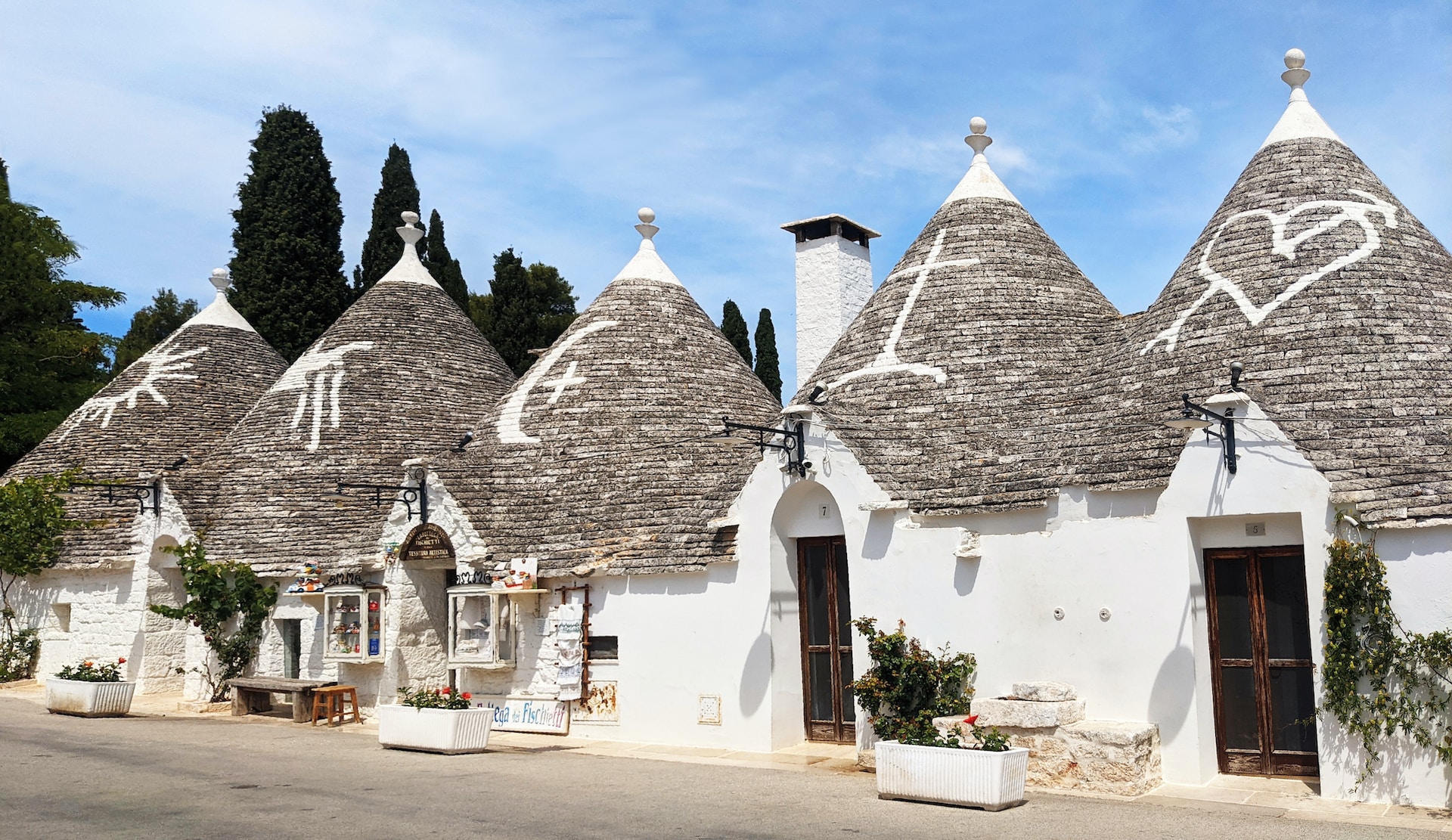Valle d’Itria, also known as the Itria Valley, is a picturesque haven nestled in the Apulia region of Southern Italy. Stretching across the provinces of Bari, Brindisi, and Taranto, this enchanting region is a harmonious blend of natural splendor and a rich tapestry of cultural heritage. As you embark on a journey through Valle d’Itria, you’ll be captivated by the undulating limestone plateaus, expansive olive groves, and flourishing vineyards that paint the backdrop of this idyllic landscape.
The very name “Itria Valley” carries echoes of the Basilian Fathers’ devotion to the Madonna Odegitria, an homage to the Virgin Mary who illuminates the way. Across the centuries, this valley has borne witness to the ebb and flow of civilizations, from the ancient Messapians, Greeks, and Romans to the Goths and Lombards. As you traverse the historic landscapes, you’ll encounter remnants of this rich history, such as the venerable Capuchin Monastery in Martina Franca, which stands as a silent witness to the diverse epochs that have shaped the region.
Yet, perhaps the most iconic and emblematic features of Valle d’Itria are the trulli. These traditional dry stone huts, with their distinctive conical roofs, stand as architectural marvels and cultural symbols. In the heart of towns like Alberobello and Locorotondo, the trulli create a whimsical and magical atmosphere, inviting exploration and sparking curiosity about their construction, symbolic adornments, and the role they play in the cultural narrative of this sun-kissed Italian haven.
Trulli: Architectural Marvels and Timeless Heritage
The trulli, scattered like enchanting domes across the landscape of Valle d’Itria, stand as unique architectural gems, contributing to the region’s distinctive charm. Trulli are characterized by their cone-shaped roofs, constructed entirely without mortar. Crafted from local limestone, these traditional dwellings feature thick walls that provide natural insulation, keeping interiors cool in the summer and warm in the winter. The conical design is not merely an aesthetic choice but a testament to the resourcefulness and ingenuity of the local builders. Roofs are often adorned with pinnacle symbols, ranging from simple shapes to intricate religious or mystical symbols, adding a touch of individuality to each trullo.
The history of trulli dates back to the 14th century, and their construction is rooted in a need for flexibility. Local legend suggests that residents built these dry stone structures to facilitate easy demolition. This was crucial as it allowed them to evade property taxes imposed by the Kingdom of Naples. The design proved effective, as inhabitants could swiftly dismantle their homes when tax collectors were in the vicinity, only to reconstruct them once the threat had passed.
Must See Towns of Valle d’Itria
Alberobello
Alberobello is characterized by its iconic trulli, ancient stone houses with distinctive conical roofs that have earned it UNESCO World Heritage status. The Rione Monti quarter is a labyrinth of over 1000 trulli, many of which have been converted into delightful souvenir shops and cafes. Trullo Sovrano, a two-story trullo dating back to the 17th century, offers a fascinating glimpse into the town’s architectural history. Visitors can wander through the enchanting Rione Aia Piccola, a less commercialized neighborhood with 400 trulli each telling its own story. The Church of St. Anthony of Padua, always strictly trullo-shaped, is a must-see for its unique blend of religious and architectural significance. While in Alberobello, indulge in the local delicacies, particularly the bombette, pork-based delicacies that showcase the region’s culinary expertise. The town’s gastronomy is a perfect complement to its architectural wonders.
Locorotondo
Locorotondo lives up to its reputation as the “most beautiful balcony in the Murgia dei Trulli.” The town’s unique spiral layout offers stunning vistas of the surrounding countryside. The Cummerse, tall white houses with pointed roofs, create a postcard-perfect scene against the backdrop of the Itria Valley. The Church of San Giorgio, the Church of the Madonna della Greca, and the Clock Tower are architectural gems that reveal the town’s historical and cultural significance. Don’t miss the Sagra degli Gnumeredde Suffuchete, Locorotondo’s summer festival celebrating the region’s culinary delights, particularly the gnummareddii, meat rolls with innards enjoyed straight from the grill.
Martina Franca
Martina Franca is a Baroque masterpiece, with its historic center showcasing architectural gems such as the Ducal Palace, an imposing baroque structure built in 1668. Piazza Roma, the town’s central square, is home to the Basilica di San Martino, an awe-inspiring church with a white marble facade. The town’s natural beauty extends to the Bosco delle Pianelle, a nature reserve where oak groves and Mediterranean scrub create a serene environment. For art enthusiasts, the Neapolitan school’s paintings from the second half of the 1700s inside the Basilica di San Martino are a captivating exploration of the town’s cultural richness. Martina Franca’s culinary scene is highlighted by local specialties such as capocollo di Martina Franca, marinated in Vincotto, and the region’s renowned wines, including Martina Franca DOP.
Cisternino
Cisternino, often hailed as one of the pearls of the Itria Valley, stands out for its gastronomic offerings and medieval architecture. The town is known for its olive oil, contributing to the region’s reputation for high-quality olive products. Beyond gastronomy, Cisternino boasts a charming historic center, inviting visitors to explore its medieval streets and discover hidden gems. Delve into Cisternino’s culinary delights, including the famous bombette, donkey meat chops, and the savory gnummareddii. The town’s commitment to preserving culinary traditions makes it a haven for food enthusiasts.
Ostuni
Ostuni, often referred to as the “white city,” is a visual spectacle rising on three hills. La Terra, the historic center, is a treasure trove of historical landmarks, including the 15th-century Cathedral and the remains of the Castle. The Ostuni Archaeological Park offers a journey through the region’s prehistoric past, with fascinating traces of dinosaurs and human settlements. Explore the local festivities, especially during the celebrations of Sant’Oronzo, the town’s patron saint. Dive into the local cuisine, featuring lampascioni, orecchiette pasta with turnip tops, and other regional delights.
Natural and Cultural Attractions
Grotte di Castellana
A must-visit for nature enthusiasts, the Castellana Caves are Italy’s longest natural subterranean network. Embark on a guided tour to witness the extraordinary formations that have been shaped over millions of years. The interlinked galleries reveal a mesmerizing display of stalactites, stalagmites, canyons, and chambers, including the breathtaking Grotta Bianca, entirely made of alabaster.
Combine the cave exploration with a visit to the Museo Speleologico Franco Anelli for a comprehensive understanding of the subterranean world.
Museo Speleologico Franco Anelli
Connected to the Grotte di Castellana, this cave museum delves into speleology and geological specimens. Combine a visit to the Grotte di Castellana with an exploration of the Museo Speleologico Franco Anelli for a comprehensive understanding of the region’s subterranean wonders.
Museo di Civiltà Preclassiche della Murgia
Located in Ostuni, this museum exhibits artifacts from the prehistoric period, including the famous exhibit “Delia.” Take your time exploring the museum’s exhibits, with a particular focus on the archaeological finds and historical artifacts that reveal Ostuni’s rich history. The Museo di Civiltà Preclassiche della Murgia is a treasure trove of artifacts from the prehistoric period. Among its notable exhibits is “Delia,” a 25,000-year-old expectant mother whose remains provide insights into ancient civilizations.
Culinary Delights of Valle d’Itria’s
Valle d’Itria’s gastronomic scene is a delightful journey for food enthusiasts. Indulge in bombette, pork-based delicacies, and the unique gnummareddii, meat rolls with innards, enjoyed on the grill. Explore the flavors of local wines, particularly Martina Franca DOC (Denominazione di origine controllata) and Locorotondo DOC white wine, each telling a story of the region’s viticulture.
Festivals in Valle d’Itria’s
The region comes alive with festivals celebrating local traditions and flavors. Experience the festive spirit in Ostuni, where Christmas celebrations create a magical atmosphere. The “white city” becomes even more enchanting during this time. Locorotondo’s summer festival, the Sagra degli Gnumeredde Suffuchete, is a celebration of local cuisine, bringing together the community and visitors to savor the region’s culinary delights.
Plan your visit around local events and festivals. Immerse yourself in the local traditions and celebrations during events like “Gift to St. George” in Locorotondo, providing a unique insight into the community’s spirit. Explore the diverse villages within the valley, each offering its own distinct charm and cultural highlights.
Travel Tips for Exploring Valle d’Itria
As you embark on your journey through Valle d’Itria, a few travel tips can enhance your experience of this enchanting region. Consider staying in a masseria, a traditional Apulian farmhouse, to immerse yourself in the authentic rural lifestyle. Masserias, scattered across the landscape, offer not only comfortable accommodations but also a deep connection to the region’s agricultural heritage.
To fully explore the picturesque towns and attractions, renting a car is not just a convenience but a necessity. The countryside’s charm lies in its remote beauty, and public transport is limited in these areas. Having your own vehicle allows you the freedom to navigate the narrow streets of Alberobello, traverse the scenic routes leading to Cisternino, and explore the hidden corners of Locorotondo. It’s a journey best undertaken at your own pace, allowing you to absorb the tranquility and tradition that define Valle d’Itria.
Conclusion
Valle d’Itria beckons travelers with a timeless tapestry woven from the threads of history, culture, and natural splendor. The trulli-studded landscapes, Baroque pearls like Martina Franca, and the rustic allure of Cisternino collectively create an immersive experience that transcends the ordinary. As you savor the flavors of local cuisine, wander through labyrinthine streets, and bask in the warm hospitality of masserias, Valle d’Itria unfolds its story—one that resonates with the echoes of ancient civilizations and the vibrant traditions of modern-day Puglia. This hidden gem invites you not merely to visit but to become a part of its living narrative, ensuring that each step through its towns and valleys leaves an indelible mark on your travel tapestry.




